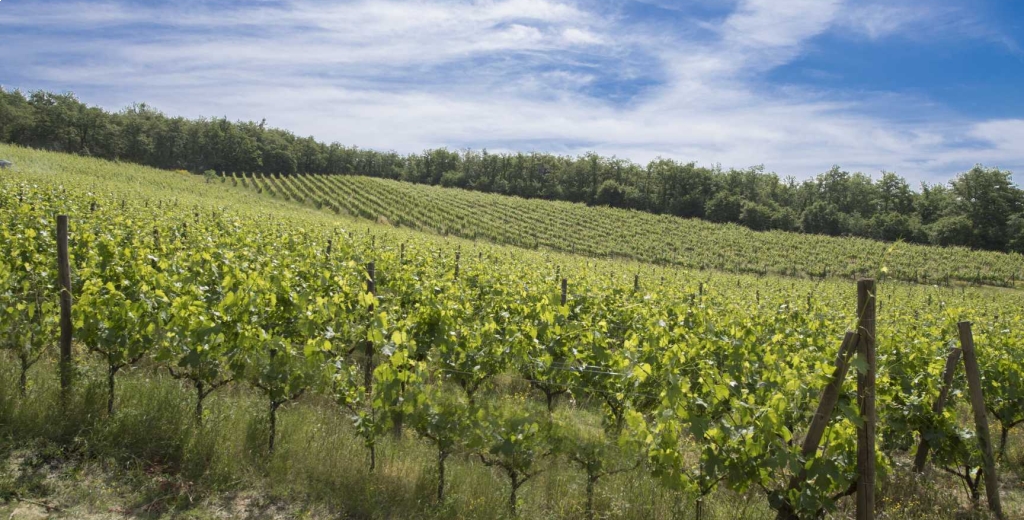VINEYARDS & WINERIES IN ITALY
An exclusive interview with our CEO Riccardo Romolini


Located in the beautiful medieval city of Anghiari, Agenzia Romolini Immobiliare has specialized in the sale of historic Tuscan and Umbrian vineyard estates since 2004. Riccardo Romolini, the firm’s CEO and Founder, spoke to Luxury Defined about the regions’ rich vinicultural heritage and resurgent vineyard property markets.
What is the significance of wine to Italy and Italians in general?
In Italy, wine is a way of life that characterizes the entire peninsula. As the world’s second largest wine producer, our country grows nearly 2,000 native grape varieties across many culturally and topographically diverse viticultural areas. There are 20 officially recognized wine regions, spanning from Lombardy, Piedmont, Liguria, Emilia-Romagna, and Aosta Valley, Veneto, Trentino-Alto Adige, and Friuli-Venezia Giulia in the north to the islands of Sicily and Sardinia, Campania, Basilicata, Puglia, and Calabria in the south. The central region comprises Lazio, Umbria, Marche, Abruzzo, Molise, Umbria, and Tuscany, the country’s and oldest and most celebrated wine region.

How are Italian wines classified?
Though countless native grape varieties have been grown for millennia, the Italian government recognizes just 405 as official controlled DOC and DOCG appellations. To guarantee their geographical origin, authenticity, and quality, wines are separated into four classifications: Vino da Tavola (VdT), or table wine; Indicazione Geografica Tipica (IGT), a wine from a specific geographical area; Denominazione di Origine Controllata (DOC), controlled designation of origin; and Denominazione di Origine Controllata e Garantita (DOCG), controlled designation of origin guaranteed. DOC and DOCG wines must comply with strict production standards. DOCG wines in fact, must pass a taste panel before bottling can occur.
Why are Tuscany and Umbria highly prized wine regions?
Revered for its unparalleled natural beauty, high quality of life, and rich culture, Tuscany’s rich viticultural provenance dates from the Etruscan period (8th to 2nd century BC). Its verdant, sloping hillsides are dotted with olive groves, cypress trees, and rolling vineyards graced with historic wine estates. The area comprises approximately 143,000 acres of vineyards with 67 DOC/DOCG controlled appellations. Some of the region’s most acclaimed wines include Vino Nobile di Montepulciano and Brunello di Montalcino, which are made with the signature Sangiovese variety; Super Tuscans, a blend of Sangiovese, Cabernet Sauvignon, and Merlot; and Vernaccia di San Gimignano, a white varietal produced in the Sienese hills.
The most famous, and arguably the most prized, of all Italian DOCG appellations, Chianti, is located in the heart of Tuscany. Produced since the 14th century, Chianti became the world’s first declared wine region in 1716 under the Grand Duke of Tuscany, Cosimo III. Today it yields some of the world’s finest wines.
Neighboring Tuscany, the region of Umbria, often referred to as “the green heart of Italy,” is set against a glorious backdrop of beautiful medieval hill towns including Perugia, Spoleto, and Assisi, with its historic Basilica di San Francesco. The region encompasses more than 40,000 vineyard acres with a total of 13 DOC and DOCG appellations, producing several world-class wines including Sagrantino di Montefalco, Torgiano Rosso Riserva, and Orvieto.
Why is Tuscany such an ideal region for grape growing?
Bestowed with hot summers and mild winters, Tuscany has a favorable grape-growing climate. The region’s unique terroir has a rich geological composition of galestro (a rocky clay soil), alberese (limestone marl), tufa (limestone and volcanic ash), and sandstone soils, which, like climate and altitude, vary widely between the coastal and inland sub-regions.

What are the properties like?
As magnificent as their idyllic surroundings, Tuscan and Umbrian vineyard estates range from medieval villas and castles to contemporary organic wineries, equipped with state-of-the-art wine production facilities. The wine estates of Tenuta di Trecciano in Siena, which produces Chianti Colli Senesi, IGT Super Tuscan, and Vinsanto varieties, and the Fattoria Viticcio estate in Chianti, with an annual yield of approximately 500,000 bottles including the multi-award-winning Viticcio Chianti Classico DOCG, were two of the region’s recent significant sales. We were honored to represent the sale of both properties in early 2015. Both sold to foreign buyers, confirming Tuscany’s major global appeal.
How is the vineyard property market faring?
The vineyard sector of Italy’s nationwide property market has seen only a partial decline in sales despite the country’s continued economic downturn. This is thanks in part to the fact that wine estates, and Italian farming estates in general, can benefit from considerable tax deductions as well as substantial fiscal subsidiaries from the European Union. The Italian government has also eased visa and mortgage restrictions for international buyers who wish to buy property.

Have you seen an uptick in interest from international buyer?
In the last six months, American, British, and Swiss buyers have shown a marked interest in purchasing Tuscan vineyard estates looking to take advantage of lower prices as a result of the current economic climate and falling euro. International buyers have their choice of prime properties that have been discounted by as much as 30–40 percent. Interest from Chinese buyers looking to purchase large vineyard properties also continues to rise.
What advice would you give to someone looking to buy an Italian vineyard?
For those looking to enter the vineyard market, expert guidance is essential due to the unique nature of the business. Important factors a buyer should consider include the type of property, acreage, facilities, appellation, and terroir, which takes into account the vineyard’s unique soil structure, geography, and climate. With advances in wine production technologies, progressive farming trends, and economic factors, vineyard ownership in Italy has become a viable proposition for both aspiring vintners and for those who just want to experience the unique vineyard lifestyle.


 Eng
Eng Ita
Ita









 Back to list
Back to list 





